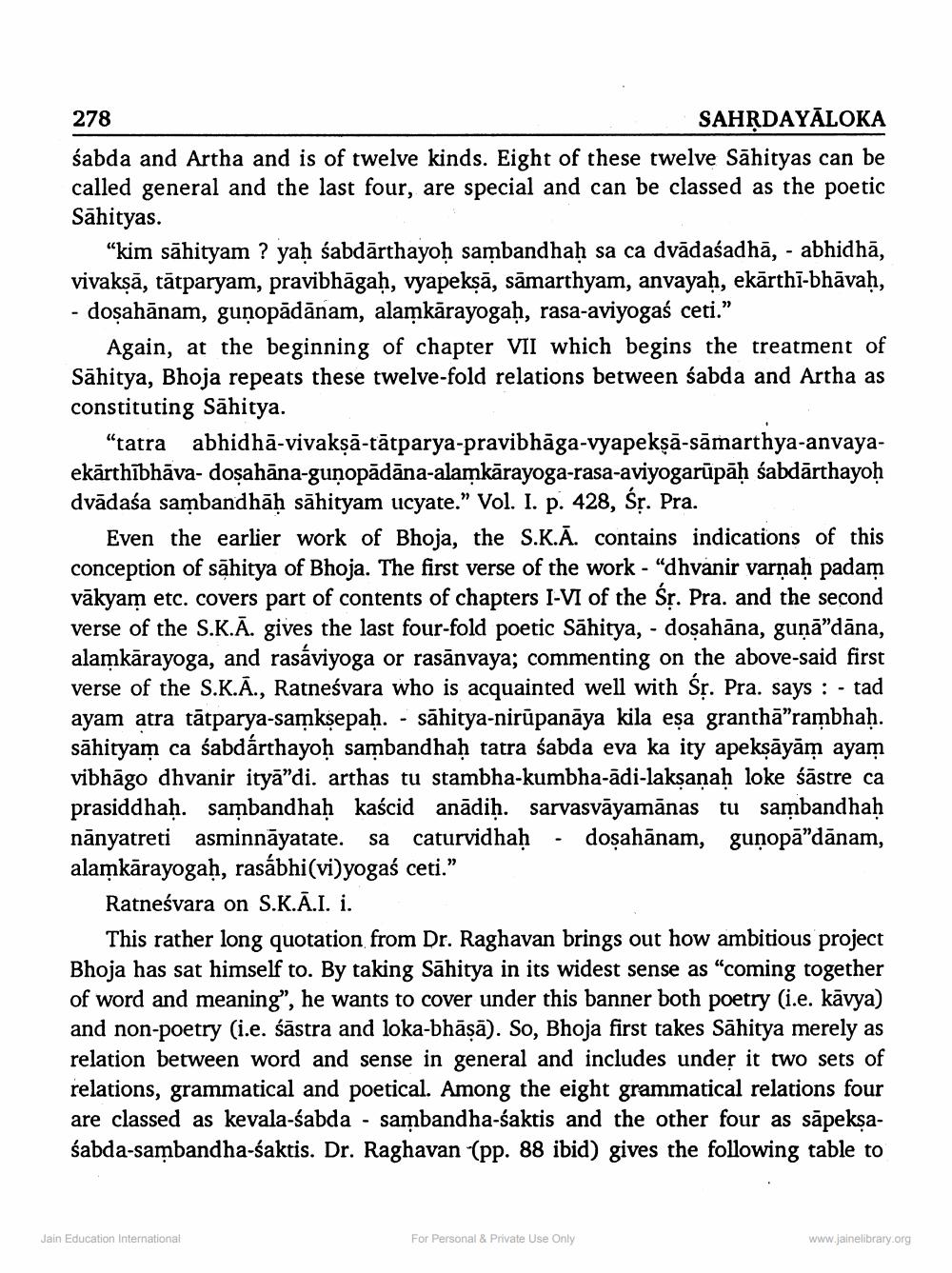________________
278
SAHRDAYĀLOKA
sabda and Artha and is of twelve kinds. Eight of these twelve Sahityas can be called general and the last four, are special and can be classed as the poetic Sāhityas.
“kim sāhityam ? yaḥ śabdārthayoḥ sambandhaḥ sa ca dvādaśadhā, - abhidhā, vivakṣā, tātparyam, pravibhāgaḥ, vyapekṣā, sāmarthyam, anvayaḥ, ekārthi-bhāvaḥ, - dosahānam, guņopādānam, alamkārayogaḥ, rasa-aviyogaś ceti.”
Again, at the beginning of chapter VII which begins the treatment of Sāhitya, Bhoja repeats these twelve-fold relations between sabda and Artha as constituting Sāhitya.
"tatra abhidhā-vivaksā-tātparya-pravibhāga-vyapekşā-sāmarthya-anvayaekārthībhāva- dosahāna-gunopādāna-alamkārayoga-rasa-aviyogarūpāḥ śabdārthayoḥ dvādaśa sambandhāḥ sāhityam ucyate.” Vol. I. p. 428, Sp. Pra.
Even the earlier work of Bhoja, the S.K.Ā. contains indications of this conception of sahitya of Bhoja. The first verse of the work - "dhvanir varnah padam vākyam etc. covers part of contents of chapters I-VI of the Śr. Pra. and the second verse of the S.K.Ā. gives the last four-fold poetic Sāhitya, - dosahāna, gunā"dāna, alamkārayoga, and rasáviyoga or rasānvaya; commenting on the above-said first verse of the S.K.A., Ratneśvara who is acquainted well with Śị. Pra, says : - tad ayam atra tātparya-samkṣepaḥ. - sāhitya-nirūpanāya kila eșa granthā"rambhaḥ. sāhityam ca sabdárthayoh sambandhaḥ tatra sabda eva ka ity apeksāyām ayam vibhāgo dhvanir ityā"di. arthas tu stambha-kumbha-ādi-laksaņaḥ loke śāstre ca prasiddhaḥ sambandhaḥ kaścid anādiḥ. sarvasvāyamānas tu sambandhaḥ nānyatreti asminnāyatate. sa caturvidhaḥ - dosahānam, guņopā”dānam, alamkārayogaḥ, rasábhi(vi)yogaś ceti.”
Ratneśvara on S.K.Ā.I. i.
This rather long quotation from Dr. Raghavan brings out how ambitious project Bhoja has sat himself to. By taking Sāhitya in its widest sense as “coming together of word and meaning", he wants to cover under this banner both poetry (i.e. kāvya) and non-poetry (i.e. śāstra and loka-bhāsā). So, Bhoja first takes Sāhitya merely as relation between word and sense in general and includes under it two sets of relations, grammatical and poetical. Among the eight grammatical relations four are classed as kevala-sabda - sambandha-śaktis and the other four as sāpekṣaśabda-sambandha-śaktis. Dr. Raghavan (pp. 88 ibid) gives the following table to
Jain Education International
For Personal & Private Use Only
www.jainelibrary.org




